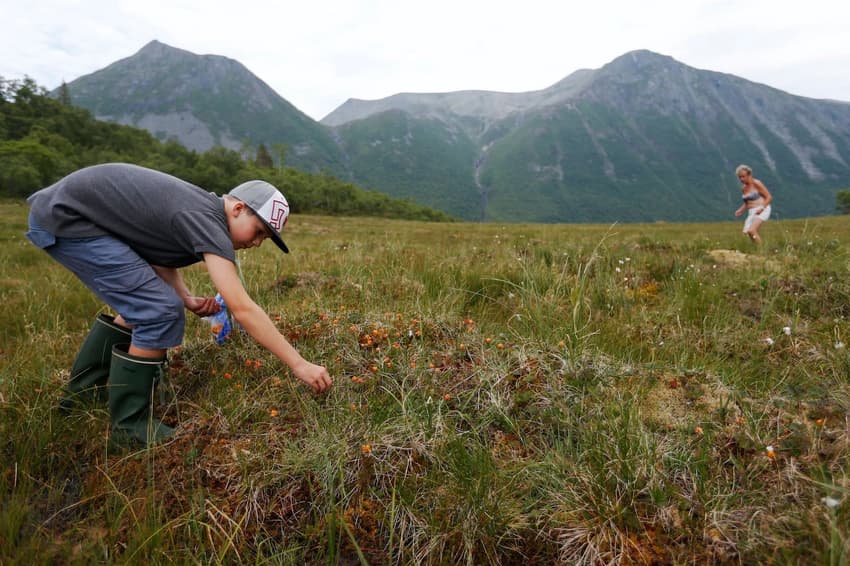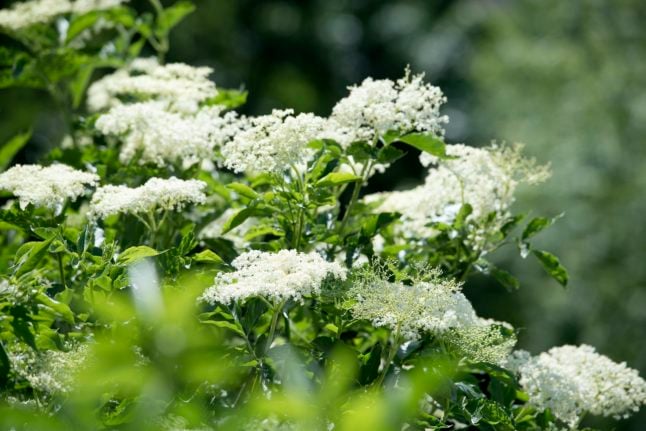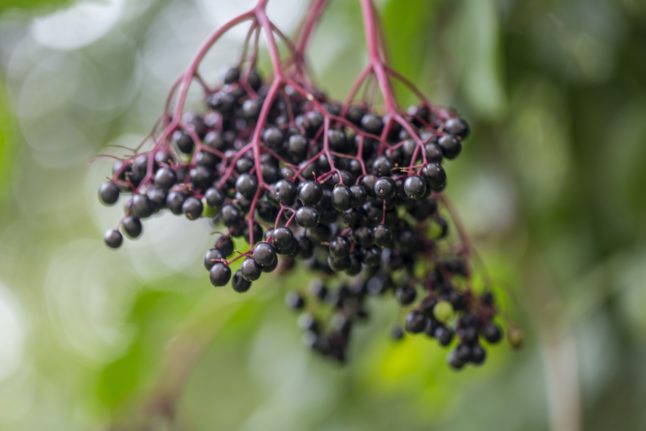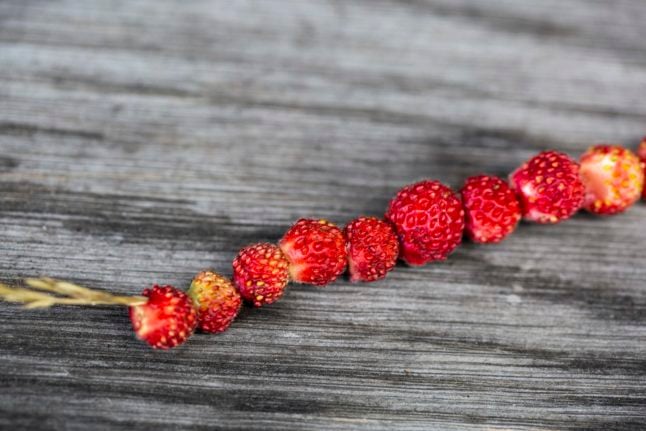Five berries and flowers you can forage in Sweden this summer

Summer is the season for flowers and berries in Sweden. What can you pick at this time of year and where can you find the rare and delicious "gold of Norrland"?
The leafy greens of spring, like ground elder, wild garlic and nettles, are still available in some areas, although the tender new leaves which popped up in May are now tougher and less appetising.
That doesn't mean there's nothing interesting to forage in Sweden this summer, as the season for flowers and berries begins.
First, let's get the ground rules for foraging out of the way.
Obviously, all of the plants in this guide grow in the wild, meaning it’s a good idea to wash them thoroughly before you use them. You should also be respectful of nature and of other would-be foragers when you’re out foraging, and make sure not to take more than your fair share to ensure there’s enough for everyone.
As with all foraged foods, only pick and eat what you know. Most of the plants in this guide do not look similar to any poisonous plants, but it’s always better to be safe than sorry – or ask someone who knows for help.
Additionally, avoid foraging plants close to the roadside or in other areas which could be more polluted. If you haven’t tried any of these plants before, start in small doses to make sure you don’t react negatively to them.
Elderflower | Fläder
Elderflowers. Photo: Maja Suslin/TT
Elder bushes, which can be up to five metres high, usually flower as early as May or June down in Skåne, with the white, fragrant flowers blooming later further north.
They are a popular bush in municipal parks as well as private gardens, so you may know someone with an elder bush who will let you harvest the blooms in return for a bottle of cordial.
In municipal parks, the rules on harvesting elderflowers under Sweden's allemansrätten -- the right to public spaces -- are a bit vague. You're not allowed to break off twigs or branches or damage a tree or bush in any way, but carefully removing flowers is usually OK. If in doubt, check your municipality's website or ask for permission before you harvest the blooms.
Bear in mind that allemansrätten sometimes doesn't apply in nature reserves, so avoid picking elderflowers or elderberries in these areas unless you're sure it's allowed.
The flowers can be collected to make elderflower cordial or fläderblomssaft, but don't worry if they've all finished blooming where you live, as the dark, almost black berries are also edible.
Elderberries can also be used to make jam, vinegar or cordial. Photo: Fotograferna Holmberg/TT
These can be pickled in salt when they're still green and unripe to make something similar to capers, or the ripe berries can be used to make elderberry gin, jam, cordial or even vinegar.
Elder bushes or äkta fläder look similar to red elder, also known as druvfläder, which is toxic, although it's easy to tell them apart when you know how. Real elderflowers grow in wide, flat, round groups, and the berries are a very dark purple, almost black in colour.
Red elder flowers are smaller and grow in cone-shaped, smaller groups, and the berries are bright red. As with all foraging, if you're not sure what it is, don't pick it, or ask someone who does know for assistance.
Smultron | Wild or alpine strawberry
Smultron, also known as wild strawberries, woodland strawberries, or Alpine strawberries, are extremely popular in Sweden. Photo: Johan Nilsson/TT
It's hard to be in Sweden during summer without hearing about smultron, the much-loved tiny strawberries which grow in Swedish woodlands. They are very easy to recognise by their tiny red fruits, and they grow very close to the ground on runners.
Wild strawberries often begin to ripen from the end of June, although you might be able to find a handful which are ready before then.
They are often used as ground cover in parks and gardens, too, as they send out runners which propagate new plants.
Most Swedes will have fond memories of eating wild strawberries like this, threaded onto a grass stem. Photo: Fotograferna Holmberg/TT
You can pick wild strawberries in most areas under Sweden's right to roam, although you should avoid picking them in private gardens or in nature reserves.
Smultron are best eaten as-is, straight off the plant. They don't store particularly well and it can be difficult to harvest large enough quantities to make jam or cordial with, and much of the flavour disappears when they're cooked anyway.
A classic Swedish summer treat is smultron threaded onto a grass stem like a tiny berry kebab, like in the picture above. Probably best not to eat the grass, though.
Vildhallon | Wild raspberry
Wild raspberries are commonly found in Swedish woodland. Photo: Audun Braastad/NTB/TT
Similar to wild strawberries, wild raspberries, known as skogshallon or vildhallon are often found in Swedish woodlands and by the side of smaller country roads. They usually ripen around July to August, or as late as September in more northern areas.
When they're dark red and easily pop off the plant, they're ready. Depending on the amount you pick, they can be eaten as-is, on top of yoghurt or ice cream, or made into jam or cordial if you have a particularly large harvest.
You're allowed to pick the berries in areas where Sweden's allemansrätten applies, but make sure to only pick the fully ripe berries, and it's nice if you can leave some for fellow foragers to pick, too.
Hjortron | Cloudberries
Hjortron, known as cloudberries in English. Photo: Lise Åserud/NTB/TT
Particularly common in northern Sweden, cloudberries are often described as skogens guld or Norrlands guld, "the forest's gold" or "Norrland's gold", due to their rarity and status as a delicacy.
Like secret mushroom spots, you may know someone who knows where you can find cloudberries, but they're unlikely to share their secret with you. Don't take this to heart, though. The knowledge of a good cloudberry spot is often passed down through generations and rarely revealed even to other family members.
Cloudberries are only found in the wild and grow in all of Sweden apart from Öland and southern Skåne, although they are most common in Norrland. They grow in wet, open areas with a lot of sunlight, like mossy bogs. You won't find them in forests or other areas with a lot of tall plants as the small 20cm-or-so high bushes need a large amount of direct sunlight to thrive.
Ripening from mid-July to mid-August, it's important to make sure you pick them when they're properly ripe, as they're hard and sour if you pick them too early. You'll know they're ready when they're a bright yellowy orange, as opposed to the darker red of unripe berries, and when they easily come off the plant.
Supposedly, you can tell when cloudberries are ripe by listening out for cuckoos. According to an old Sámi saying, "the cuckoo gets cloudberries stuck in its throat", meaning that the cloudberries are ready for picking when you stop hearing the cuckoo's call, usually around mid-July.
Cloudberries are commonly used to make cloudberry jam (which you can also buy at Ikea if you live outside Sweden and are curious about the flavour), or eaten fresh with cream on pancakes or other desserts.
Comments
See Also
The leafy greens of spring, like ground elder, wild garlic and nettles, are still available in some areas, although the tender new leaves which popped up in May are now tougher and less appetising.
That doesn't mean there's nothing interesting to forage in Sweden this summer, as the season for flowers and berries begins.
First, let's get the ground rules for foraging out of the way.
Obviously, all of the plants in this guide grow in the wild, meaning it’s a good idea to wash them thoroughly before you use them. You should also be respectful of nature and of other would-be foragers when you’re out foraging, and make sure not to take more than your fair share to ensure there’s enough for everyone.
As with all foraged foods, only pick and eat what you know. Most of the plants in this guide do not look similar to any poisonous plants, but it’s always better to be safe than sorry – or ask someone who knows for help.
Additionally, avoid foraging plants close to the roadside or in other areas which could be more polluted. If you haven’t tried any of these plants before, start in small doses to make sure you don’t react negatively to them.
Elderflower | Fläder
Elder bushes, which can be up to five metres high, usually flower as early as May or June down in Skåne, with the white, fragrant flowers blooming later further north.
They are a popular bush in municipal parks as well as private gardens, so you may know someone with an elder bush who will let you harvest the blooms in return for a bottle of cordial.
In municipal parks, the rules on harvesting elderflowers under Sweden's allemansrätten -- the right to public spaces -- are a bit vague. You're not allowed to break off twigs or branches or damage a tree or bush in any way, but carefully removing flowers is usually OK. If in doubt, check your municipality's website or ask for permission before you harvest the blooms.
Bear in mind that allemansrätten sometimes doesn't apply in nature reserves, so avoid picking elderflowers or elderberries in these areas unless you're sure it's allowed.
The flowers can be collected to make elderflower cordial or fläderblomssaft, but don't worry if they've all finished blooming where you live, as the dark, almost black berries are also edible.
These can be pickled in salt when they're still green and unripe to make something similar to capers, or the ripe berries can be used to make elderberry gin, jam, cordial or even vinegar.
Elder bushes or äkta fläder look similar to red elder, also known as druvfläder, which is toxic, although it's easy to tell them apart when you know how. Real elderflowers grow in wide, flat, round groups, and the berries are a very dark purple, almost black in colour.
Red elder flowers are smaller and grow in cone-shaped, smaller groups, and the berries are bright red. As with all foraging, if you're not sure what it is, don't pick it, or ask someone who does know for assistance.
Smultron | Wild or alpine strawberry
It's hard to be in Sweden during summer without hearing about smultron, the much-loved tiny strawberries which grow in Swedish woodlands. They are very easy to recognise by their tiny red fruits, and they grow very close to the ground on runners.
Wild strawberries often begin to ripen from the end of June, although you might be able to find a handful which are ready before then.
They are often used as ground cover in parks and gardens, too, as they send out runners which propagate new plants.
You can pick wild strawberries in most areas under Sweden's right to roam, although you should avoid picking them in private gardens or in nature reserves.
Smultron are best eaten as-is, straight off the plant. They don't store particularly well and it can be difficult to harvest large enough quantities to make jam or cordial with, and much of the flavour disappears when they're cooked anyway.
A classic Swedish summer treat is smultron threaded onto a grass stem like a tiny berry kebab, like in the picture above. Probably best not to eat the grass, though.
Vildhallon | Wild raspberry
Similar to wild strawberries, wild raspberries, known as skogshallon or vildhallon are often found in Swedish woodlands and by the side of smaller country roads. They usually ripen around July to August, or as late as September in more northern areas.
When they're dark red and easily pop off the plant, they're ready. Depending on the amount you pick, they can be eaten as-is, on top of yoghurt or ice cream, or made into jam or cordial if you have a particularly large harvest.
You're allowed to pick the berries in areas where Sweden's allemansrätten applies, but make sure to only pick the fully ripe berries, and it's nice if you can leave some for fellow foragers to pick, too.
Hjortron | Cloudberries
Particularly common in northern Sweden, cloudberries are often described as skogens guld or Norrlands guld, "the forest's gold" or "Norrland's gold", due to their rarity and status as a delicacy.
Like secret mushroom spots, you may know someone who knows where you can find cloudberries, but they're unlikely to share their secret with you. Don't take this to heart, though. The knowledge of a good cloudberry spot is often passed down through generations and rarely revealed even to other family members.
Cloudberries are only found in the wild and grow in all of Sweden apart from Öland and southern Skåne, although they are most common in Norrland. They grow in wet, open areas with a lot of sunlight, like mossy bogs. You won't find them in forests or other areas with a lot of tall plants as the small 20cm-or-so high bushes need a large amount of direct sunlight to thrive.
Ripening from mid-July to mid-August, it's important to make sure you pick them when they're properly ripe, as they're hard and sour if you pick them too early. You'll know they're ready when they're a bright yellowy orange, as opposed to the darker red of unripe berries, and when they easily come off the plant.
Supposedly, you can tell when cloudberries are ripe by listening out for cuckoos. According to an old Sámi saying, "the cuckoo gets cloudberries stuck in its throat", meaning that the cloudberries are ready for picking when you stop hearing the cuckoo's call, usually around mid-July.
Cloudberries are commonly used to make cloudberry jam (which you can also buy at Ikea if you live outside Sweden and are curious about the flavour), or eaten fresh with cream on pancakes or other desserts.






Join the conversation in our comments section below. Share your own views and experience and if you have a question or suggestion for our journalists then email us at [email protected].
Please keep comments civil, constructive and on topic – and make sure to read our terms of use before getting involved.
Please log in here to leave a comment.